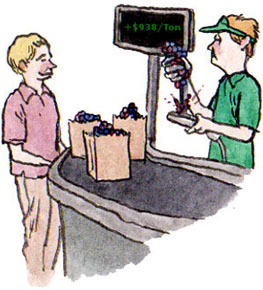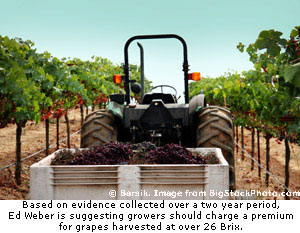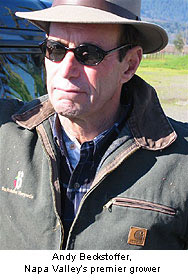

If growers add a 5% surcharge for
grapes harvested above 26 Brix,
some Napa vintners may reconsider extended hang times.
Growers Weigh in on the Hangtime Debate
“(We’re looking for) a mutual understanding and a beneficial relationship. Some growers get a high price for their grapes, (but they) let you choose the watering regime and pick when you want. Now that's service. But it comes at a price.”~ Remi Cohen, Merryvale Vineyards
by
Alan Goldfarb
November 23, 2006
If you buy Napa Valley Cabernet Sauvignon grapes -- or if you purchase a Napa Valley wine made from contracted or purchased fruit as opposed to one made with estate grown grapes -- expect to pay more for it, perhaps beginning with the 2007 vintage.
 At that time, winemakers and vintners may have to pony up an additional 5 percent for every degree of sugar per ton of grapes (over a predetermined figure), that eventually wends its way into a bottle. The added revenue will be tacked on to compensate growers for weight loss of their grapes which have dehydrated due to prolonged maturation or “hang time.” Expect the added tariff – which will mostly become the norm throughout California -- to be passed onto the consumer.
At that time, winemakers and vintners may have to pony up an additional 5 percent for every degree of sugar per ton of grapes (over a predetermined figure), that eventually wends its way into a bottle. The added revenue will be tacked on to compensate growers for weight loss of their grapes which have dehydrated due to prolonged maturation or “hang time.” Expect the added tariff – which will mostly become the norm throughout California -- to be passed onto the consumer.
A two-year survey was conducted by the Napa County UC Cooperative Extension to determine the amount of weight loss in grapes that have experienced extended ripening. It was concluded that growers are losing money when their contracted clients insist on the practice of hang time. This regimen has been utilized for many years, as winemakers try to coax as much sugar and maturity out of the grapes as possible. But, by doing so, growers have complained that as sugar levels increase, their grapes dehydrate, which results in weight loss, and therefore clients have been getting away with paying less.
The survey was presented on November 14 to a couple of hundred wine industry observers, who gathered in the city of Napa in a dingy hall at the Napa Valley Fairgrounds that is normally used for playing bingo. As part of the 9th annual Napa Valley Viticulture Fair, University of California farm advisor Ed Weber revealed his findings after 2 years of studying dehydration losses in Cabernet. Fruit from the 2005 vintage and the recent ’06 harvest was picked from five vineyards that ranged from Calistoga in the northern part of the county, to Rutherford and Oakville in the central part of the valley.
Weber indicated there was indeed a tangible weight loss due to the protracted growing period. In the Calistoga vineyard for instance, which is in the hottest region in the valley, total dehydration yields in ’06 were down approximately 21.3 percent to a low of 13.2 in one of the central valley vineyards; while the previous vintage revealed a range of weight loss from 6.9 to 15.4.
In other words, if a client purchases Cabernet -- at about $5-7,500 a ton, which is a typical rate from the best Napa Valley vineyards -- for every degree of Brix over 26, a fee of $250-375 per ton will be added. Extrapolated for the most expensive vineyard for grapes picked at the higher level of the spectrum -- say 28.5 -- a customer will pay an extra $938 per ton.
(As a frame of reference, 24 percent Brix used to be the desired number for Napa Valley Cabernet. Now, in the post-phylloxera era since the early 1990s, the average has probably been about 25.5 percent. But nowadays, it’s becoming common practice to wait until Brix levels have reached upwards of 26 to 28.5 degrees, or even higher, as in the case for some Zinfandel. At those levels, that can add up to a lot of additional revenue for the grower; and conversely, a lot more money for the vintner and by extension, the consumer.)
 Andy Beckstoffer, whose vineyard management company is the largest holder of Napa Valley vineyard acreage at over 1,000, first brought the issue of weight/revenue loss due to hang time to the industry’s attention more than two years ago.
Andy Beckstoffer, whose vineyard management company is the largest holder of Napa Valley vineyard acreage at over 1,000, first brought the issue of weight/revenue loss due to hang time to the industry’s attention more than two years ago.
Will Beckstoffer enact Weber’s suggested number of 5 percent per degree over 26 percent Brix to his forthcoming grape contracts?
“We’re still weighing the data, but I think it’s a place to start,” he told me as he emerged from Zinfandel Hall where he had listened to the presentation. “But we have to be careful not to charge too much for our product. We don’t want to put wineries out of business.
“We have to find some way to perhaps increase yields, while at the same time eliminate veggie character (a goal of winemakers, which is one reason to keep the grapes on the vine longer) and have balanced wines.” (The latter is a by-product of hang time that pushes up sugar levels, and thereby coaxes alcohol levels to such heights as to engender a wine out of balance.)
However, winemakers, who for a long while have benefited from hang time, have figured out techniques to mitigate high alcohol percentages by adding water back (a widely used and legal practice in California, although it legally applies only “to facilitate fermentation.”) or by employing a spinning cone to cut back alcohol levels or by reverse osmosis.
To which Ed Weber commented, “Brix is irrelevant. If I was growing grapes, I’d throw away my refractometer (a device used to measure ripeness of grapes) because water can be used and alcohol can be reduced in the cellar.
“However, Brix levels are still prominent for growers … in structuring (grape) contracts.”

 At that time, winemakers and vintners may have to pony up an additional 5 percent for every degree of sugar per ton of grapes (over a predetermined figure), that eventually wends its way into a bottle. The added revenue will be tacked on to compensate growers for weight loss of their grapes which have dehydrated due to prolonged maturation or “hang time.” Expect the added tariff – which will mostly become the norm throughout California -- to be passed onto the consumer.
At that time, winemakers and vintners may have to pony up an additional 5 percent for every degree of sugar per ton of grapes (over a predetermined figure), that eventually wends its way into a bottle. The added revenue will be tacked on to compensate growers for weight loss of their grapes which have dehydrated due to prolonged maturation or “hang time.” Expect the added tariff – which will mostly become the norm throughout California -- to be passed onto the consumer.A two-year survey was conducted by the Napa County UC Cooperative Extension to determine the amount of weight loss in grapes that have experienced extended ripening. It was concluded that growers are losing money when their contracted clients insist on the practice of hang time. This regimen has been utilized for many years, as winemakers try to coax as much sugar and maturity out of the grapes as possible. But, by doing so, growers have complained that as sugar levels increase, their grapes dehydrate, which results in weight loss, and therefore clients have been getting away with paying less.
The survey was presented on November 14 to a couple of hundred wine industry observers, who gathered in the city of Napa in a dingy hall at the Napa Valley Fairgrounds that is normally used for playing bingo. As part of the 9th annual Napa Valley Viticulture Fair, University of California farm advisor Ed Weber revealed his findings after 2 years of studying dehydration losses in Cabernet. Fruit from the 2005 vintage and the recent ’06 harvest was picked from five vineyards that ranged from Calistoga in the northern part of the county, to Rutherford and Oakville in the central part of the valley.
Weber indicated there was indeed a tangible weight loss due to the protracted growing period. In the Calistoga vineyard for instance, which is in the hottest region in the valley, total dehydration yields in ’06 were down approximately 21.3 percent to a low of 13.2 in one of the central valley vineyards; while the previous vintage revealed a range of weight loss from 6.9 to 15.4.
| 2005 | 2006 | |||
| Cluster Wt. | Yield per acre | Cluster Wt. | Yield per acre | |
| Vyd 1 | + 3.7% | + 7.4% | ||
| Vyd 2 | - 3.6% | - 10.0% | - 16.1% | - 17.2 |
| Vyd 3 | - 0.5% | - 6.9% | - 8.7% | - 14.3 |
| Vyd 4 | - 3.4% | - 13.9% | - 16.4% | - 13.2 |
| Vyd 5 | - 14.3% | - 15.4% | - 10.9% | - 21.3 |
Courtesy: Ed Weber, Napa County Viticulture Farm Advisor, UC Cooperative Extension office
- (According to Weber, no single entity paid for the study and a number of private companies -- including Beckstoffer Vineyard Management -- contributed supplies, labor, or facilities toward the project.)
In other words, if a client purchases Cabernet -- at about $5-7,500 a ton, which is a typical rate from the best Napa Valley vineyards -- for every degree of Brix over 26, a fee of $250-375 per ton will be added. Extrapolated for the most expensive vineyard for grapes picked at the higher level of the spectrum -- say 28.5 -- a customer will pay an extra $938 per ton.
(As a frame of reference, 24 percent Brix used to be the desired number for Napa Valley Cabernet. Now, in the post-phylloxera era since the early 1990s, the average has probably been about 25.5 percent. But nowadays, it’s becoming common practice to wait until Brix levels have reached upwards of 26 to 28.5 degrees, or even higher, as in the case for some Zinfandel. At those levels, that can add up to a lot of additional revenue for the grower; and conversely, a lot more money for the vintner and by extension, the consumer.)
 Andy Beckstoffer, whose vineyard management company is the largest holder of Napa Valley vineyard acreage at over 1,000, first brought the issue of weight/revenue loss due to hang time to the industry’s attention more than two years ago.
Andy Beckstoffer, whose vineyard management company is the largest holder of Napa Valley vineyard acreage at over 1,000, first brought the issue of weight/revenue loss due to hang time to the industry’s attention more than two years ago.Will Beckstoffer enact Weber’s suggested number of 5 percent per degree over 26 percent Brix to his forthcoming grape contracts?
“We’re still weighing the data, but I think it’s a place to start,” he told me as he emerged from Zinfandel Hall where he had listened to the presentation. “But we have to be careful not to charge too much for our product. We don’t want to put wineries out of business.
“We have to find some way to perhaps increase yields, while at the same time eliminate veggie character (a goal of winemakers, which is one reason to keep the grapes on the vine longer) and have balanced wines.” (The latter is a by-product of hang time that pushes up sugar levels, and thereby coaxes alcohol levels to such heights as to engender a wine out of balance.)
However, winemakers, who for a long while have benefited from hang time, have figured out techniques to mitigate high alcohol percentages by adding water back (a widely used and legal practice in California, although it legally applies only “to facilitate fermentation.”) or by employing a spinning cone to cut back alcohol levels or by reverse osmosis.
To which Ed Weber commented, “Brix is irrelevant. If I was growing grapes, I’d throw away my refractometer (a device used to measure ripeness of grapes) because water can be used and alcohol can be reduced in the cellar.
“However, Brix levels are still prominent for growers … in structuring (grape) contracts.”

Print this article | Email this article | More about Napa Valley | More from Alan Goldfarb














